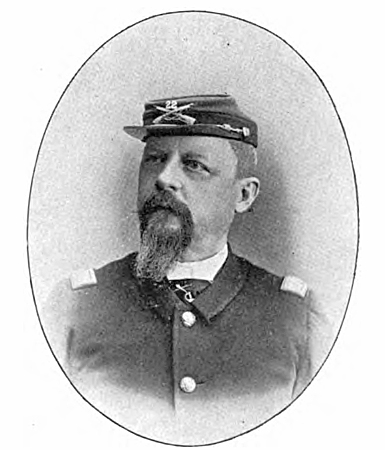

COLONEL PETER TYRER SWAINE
Commanding Officer 22nd Infantry
April 18, 1884 - January 21, 1895
Peter T. Swaine was the second
Commander of the 22nd Infantry after its reconstitution in 1866.
He was promoted to Colonel of the 22nd Infantry on April 18,
1884, brought the Regiment to Fort Keogh,
Montana in 1888 and served with it there until his retirement on
January 21, 1895.
Swaine graduated from the U.S.
Military Academy on July 1, 1852, 24 out of a class of 47. His
best subjects
were Drawing and Infantry tactics and his worst subjects were
French and English. Graduating 9th in the
same class was David S. Stanley who would later become the first
Commander of the 22nd Infantry
after its reconstitution in 1866. (Stanley would relinquish
Command of the 22nd Infantry to Swaine in 1884.)
Graduating 38th in the class was
George Crook who would later become famous
as a General in the campaigns against Sitting Bull and the Sioux
and Geronimo and the Apaches.
Also in the same class, though not graduating because he was held
back one year was Philip H. Sheridan,
who would later become Swaine's Commanding Officer as
General-in-Chief of the Army.
The following is Swaine's
official military history as recorded in Cullum's Registers of
the Officers and Graduates
of the U.S. Military Academy:
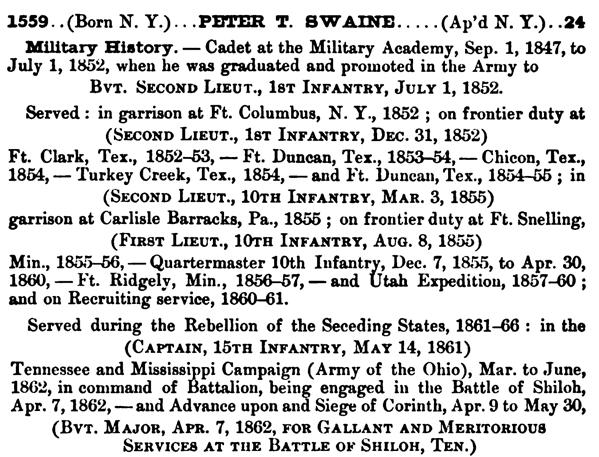
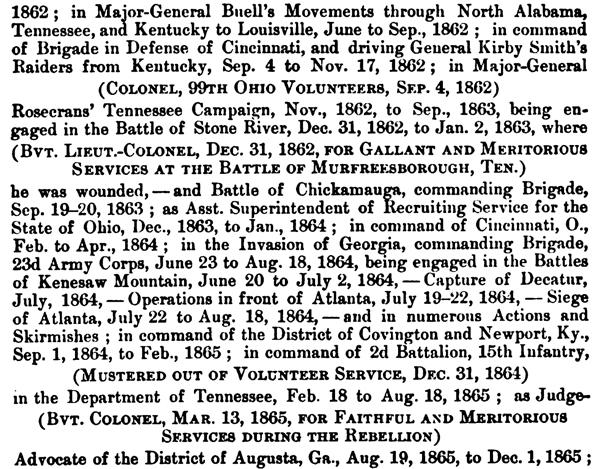
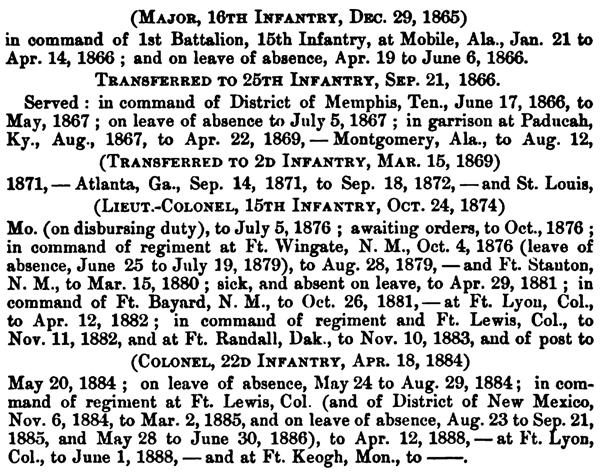

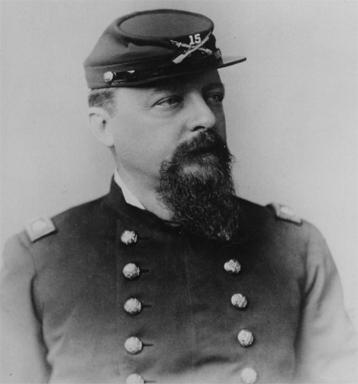
Peter T. Swaine as a Lieutenant Colonel with the 15th US Infantry, ca. 1874-1884
Photo: US Army Military Academy Library
Swaine served as a Captain in
the 15th Infantry for the first year of the Civil War,
being awarded a brevet promotion to Major for his gallantry at
the Battle of Shiloh.
In the second year of the war he was appointed Colonel of
Volunteers and given
command of the 99th Ohio Infantry. He led the 99th for two and a
half years
and received two more brevet promotions during the war, first to
Lieutenant Colonel
and then to Colonel.
The following excerpts describe
Swaine's distinguished service during the Civil War,
relate some biographical notations and give personal insights
about Swaine's physical appearance and character.
The information below is taken from the book, A Shouting of Orders: A History of the 99th Ohio Volunteer Infantry Regiment, by Kevin B. McCray.
Colonel Swaine made his first appearance before the Ninety-ninth on December 3. “Just as I was ready to start with regiment [out to picket duty] Colonel P.T. Swaine came into camp and I talked with him a few minutes,” Cummins wrote in his diary for the day. “He is a small, spare man about thirty years old, light whiskers and mustache, brown hair. I was well pleased with his appearance and hope our relations may prove agreeable. He returned to Nashville saying he would join the regiment for duty tomorrow. He was appointed at the time Langworthy was removed and has since been commanding a brigade. Is a captain in the Fifteenth Regulars.”[1] Peter Tyrer Swaine was admitted to the U.S. Military Academy at West Point , New York , on September 1, 1847, at the age of sixteen years, seven months. He was a resident of New York City (4th Congressional District) and was appointed from New York. In June 1850, Swaine was found deficient in chemistry at the year-end examination, causing him to be turned back to repeat his second class (junior) year. Swaine successfully repeated his second class year and proceeded with the studies of the first class year (senior). He graduated as a Brevet Second Lieutenant, 1st Infantry, July 1, 1852, ranked twenty-fourth in a class of forty-three members. He served in the garrison at Ft. Columbus , New York immediately upon graduation, and then was sent to frontier duty at Ft. Clark , Texas , where he was made a Second Lieutenant, 1st Infantry, on December 31, 1852. In 1853, he moved on to Ft. Duncan , Texas , to Chicon and Turkey Creek , Texas in 1854, and back to Ft. Duncan in 1855 . [2] Swaine was moved to the Tenth Infantry on March 3, 1855 while garrisoned at Carlisle Barracks, Pennsylvania . While on frontier duty at Minnesota 's Fort Snelling , he was made a First Lieutenant, Tenth Infantry, on August 8, 1855. He was the Tenth's quartermaster from December 7, 1855 to April 30, 1860, posted during that time at Ft. Ridgely , Minnesota through 1857, and as part of the Utah Expedition of 1857 to 1860. Serving as a recruiter when the rebellion broke out, he was made Captain of the Fifteenth Infantry on May 14, 1861, serving in the Tennessee and Mississippi Campaign of the Army of the Ohio from March through June 1862, including commanding a battalion at Shiloh , April 7, 1862. He was also a part of the advance upon and siege of Corinth , April 9 through May 30. Swaine was an acquaintance of General William T. Sherman.[3] In his memoir, How Soldiers Were Made, Benjamin F. Scribner, colonel of the Thirty-eighth Indiana Volunteer Infantry, describes a meeting at Lebanon Junction, Kentuckyduring September 1861, between Sherman, Scribner, Swaine, and others. Following the meeting, Scribner asked Sherman to place his Hoosier regiment under the command of someone other than a volunteer colonel. “I had closely observed Captain Swaine,” Scribner wrote, “and was much impressed with his style and bearing, and it was he I had in my mind for a commander.”[4] Promoted to Brevet Major for "gallant and meritorious services" at Shiloh, Swaine served with Major-General Don Carloss Buell during his June to September maneuvers through northern Alabama , Tennessee and Kentucky . He was in command of a brigade defending Cincinnati and Kentucky when the call came September 4 to name him Colonel of the Ninety-ninth Ohio. [5] His appointment made Swaine fifteenth in lineal rank among field officers in Ohio volunteer regiments.[6] Surgeon J.T. Woods later described Swaine at length. You will remember him well. He was as genial a friend as ever clasped a hand - as courtly a gentleman as ever smiled at the fair - and as gallant a soldier as ever buckled on a saber. You will remember how, after that fruitless and disgusting march, in which as raw recruits we were dragged through the Kentucky campaign in '62, by Buell, in a fictitious pursuit after Bragg, and in what an utterly broken-down and dispirited condition he found us in camp near Nashville, Tennessee. It was to his skill, his discipline and his offices as the most accomplished drill-master of the United States service, that the Ninety-ninth Ohio Volunteers became unrivaled among volunteers and unabashed in relation to everything that pertained to the soldier, even in the presence of regulars, not at all omitting the actual shock of battle. As an organization we owe him a debt of gratitude, and as an individual now in the path of peaceful pursuits, I cannot refrain from 'rendering unto Caesar the things that are Caesar's.' You will remember that he was rather under size, with a clear complexion, thin mustache, and with a young look that did not tell of the pith that had 'set squadrons in the field.' He was scrupulously neat in his apparel, and on this occasion wore a bright blue overcoat, the cape of which (lined with red) was thrown back over his shoulders. For some reason on this field he rode a white horse through the entire series of actions, which made him, with his blue overcoat and the displayed red of his cape, a conspicuous object. A voice cannot be described. That of Col. Swaine was singularly sweet and musical, and for purpose of drill and battle, most perfectly under his control. Mid all the clash and din, it rang out clear and distinct, without tremor or confusion, and that clear voice giving, in battle, commands as precise as on parade, thrilled many a heart on that day, and the little Colonel on his white horse, moving to and fro, is a picture that none who saw it will be likely to forget.[7] |
[1] Diary of Lt. Colonel John E. Cummins, December 3, 1862. Collection of Roger D. Hunt.
[2] Swaine married May 6, 1854, in Texas . Ironically, his wife and the wife of Lt. Colonel John Cummins both attended school together at Dayton , Ohio .
[3] Swaine’s relationship with Sherman would manifest itself in an unusual way following the war. In the Fall of 1878, Sherman, also a regent of the Smithsonian Institution, wrote Swaine (then Colonel at Fort Wingate in the New Mexico Territory) directing him to secure interesting samples of petrified trees for the Institution. In the spring of 1879, Swaine dispatched a command who secured the trees for the museum.
[4] Scribner, Benjamin F. How Soldiers Were Made. (Huntington, West Virginia: Blue Acorn Press, 1995, reprinted from 1887 original published at Chicago by Donohue & Henneberry), pp. 23-29
[5] Bvt. Major General George W. Cullum, Biographical Register of the Officers and Graduates of the U.S. Military Academy at West Point, N.Y., 3rd edition, Vol. II., (Boston: Houghton, Mifflin and Company, 1891), p. 494.
[6] Annual Report of the Adjutant General, to the Governor of the State of Ohio , for the Year Ending December 31, 1864, (Columbus: Richard Nevins, State Printer, 1865), p. 106.
[7] J.T. Woods, Steedman and His Men at Chickamauga , pp. 112 - 114
The
website is grateful to Kevin McCray for the above information
taken from his book:
A
Shouting of Orders: A History of the 99th Ohio Volunteer Infantry
Regiment
by Kevin B. McCray
ISBN: 1-4010-9760-X (Trade Paperback)
ISBN: 1-4010-9761-8 (Hardback)
which is available at the following locations:
The author may be contacted at:
Kevin
McCray
313 Sterling Court
Westerville, Ohio 43082
kmccray@columbus.rr.com
**********************
Peter T. Swaine was an Original Companion of the Military Order of the Loyal Legion of the United States.
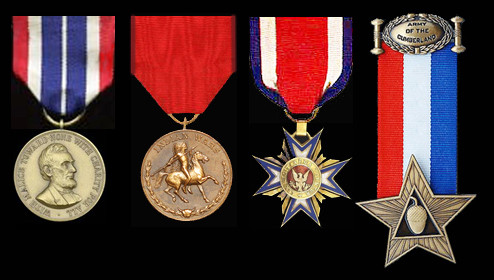
Peter T. Swaine's decorations
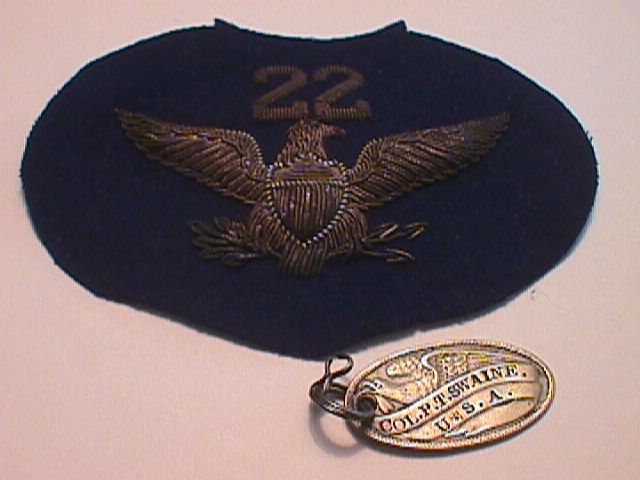
Colonel Peter T.
Swaine's dress uniform shoulder board rank
as Commander of the U.S. 22nd Infantry Regiment
and his personal identification tag.
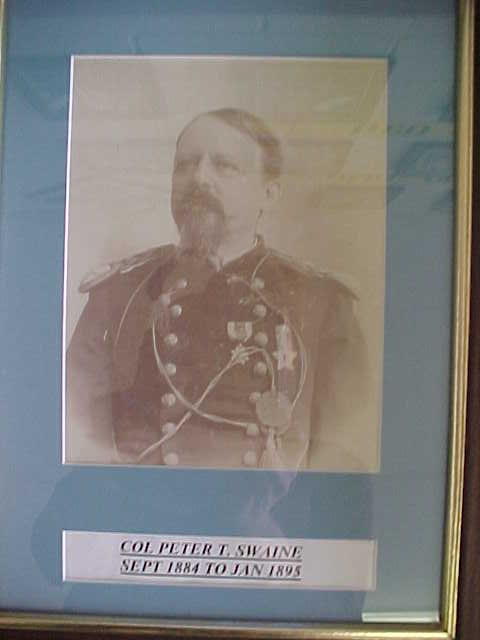
This portrait of Colonel
Peter T. Swaine hung
on the wall at 1st Battalion 22nd Infantry Headquarters
at Fort Hood, Texas, 1999-2009. Photo courtesy of Major Anne
LeGare, wife of LTC Marc LeGare,
Commanding Officer 1-22 IN 1999-2001.

The signature of Peter T. Swaine as
Commanding Officer 22nd Infantry
on the monthly Return of the 22nd Infantry for February 1889.
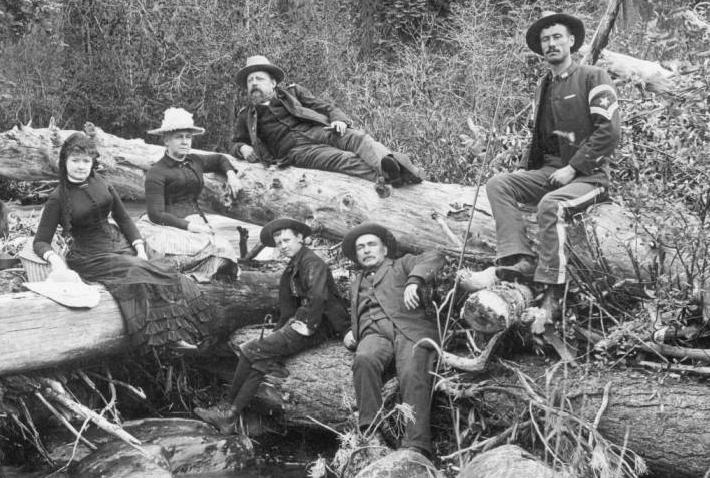
A fishing trip on the
Pine River, Colorado, 1887.
Reclining on the log at the top of the photo is Colonel Peter
Swaine.
In the foreground, left to right, are: Mrs. William Conway; Mrs.
Peter Swaine;
the youth is identified in a similar photo taken at the same time
in the book Photographer On An Army Mule
as Swaine's son William. However, in 1887 William was a 2nd
Lieutenant assigned to the 22nd Infantry.
This youth must be one of Swaine's other sons, either Edgar or
Charles, most likely Charles. To the right
of the youth is Captain William Conway, Commanding Officer of
Company D 22nd Infantry (1880-1890).
Conway entered the Army in 1861 and was with the 22nd Infantry
from 1870-1895 when he retired.
The Infantry Ordnance Sergeant Major on the log in the top right
is unidentified.
Photo by Christian Barthelmess,
Musician/Photographer of the 22nd Infantry,
from the Library of Congress
|
Colonel Peter Swaine's
farewell Signed by 1st Lieutenant F.B.
Jones This is the earliest known use
of the "Deeds Not Words". |
The following article announced Swaine's retirement:
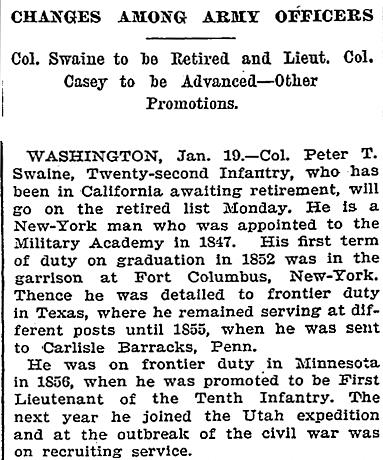
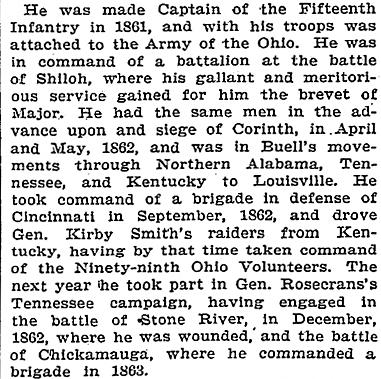
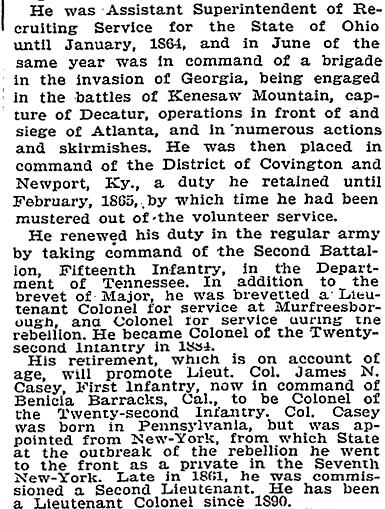
From The New York Times, January 20, 1895
The following article announced the death of Peter T. Swaine:
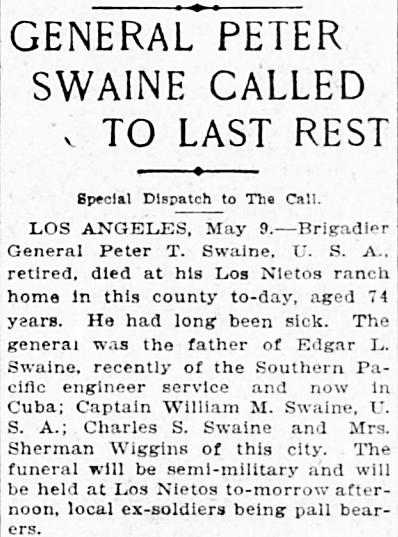
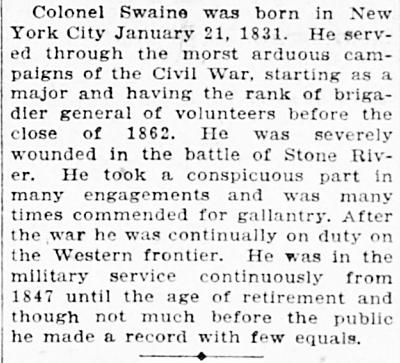
From The San Francisco Call, Tuesday, May 10, 1904
LAST HONORS TO GEN. SWAINE
COMPANIONS OF LOYAL LEGION ATTEND BURIAL
Semi-Military Obsequies at Rosedale Cemetery – Musketry
Volleys Speak a Salute to the Dead –
One Firing Squad Man Saw Service With the Deceased.
With fitting ceremonies, the remains of Brig. Gen. Peter T.
Swaine , U.S.A. retired, were given sepulture in
Rosedale Cemetery yesterday. The obsequies were semi-military in
character and were attended by the
Southern California Association of Companions of the Loyal Legion
and by members of other patriotic bodies.
An Episcopal service was
conducted at the ranch home at Los Nietos by Rev. Dr. J.J.
Wilkins, dean of the Pro-Cathedral
of this city. The funeral party came by private car on the
Pacific Electric Railway to Los Angeles and was transferred
to a car of the Los Angeles Railway. Accompanied by another
private car bearing Companions of the Loyal Legion,
the party proceeded to Rosedale.
Headed by a firing squad, the
procession formed at the cemetery entrance. Following the casket,
were
Companions of the Loyal Legion and veterans of the Grand Army.
Rev. Dr. Wilkins officiated at
the grave. When the corpse had been lowered, the welkin thrice
rang with the musketry
speaking its salute to the dead. "Taps" sounded by
Bugler, O.T. Thomas concluded the ceremony.
The honorary pall bearers were
Gen. E. Bouton, Gen. Charles D. Viele, Gen. H. G. Otis, Gen. L.H.
Rucker, Col. E.W. Jones,
Maj. W. L. Sanborn, Maj. E.F.C. Klokke and Maj. W.B. Kennedy. The
active bearers were A.L. Reed, Frank Sanchez, Eli King,
Sherman Smith, T. L. Gouch and John Ramirez.
(The next two paragraphs are
composed of the names of the members of the firing squad
and who represented the Southern California Veterans'
Association.)
Among the numerous floral pieces
was an ivy wreath with purple ribbons bearing the initials
"M.O.L.L.U.S.',
the regulation emblem of the Military Order of the Loyal Legion
of the United States. The Army Ladies' Card Club
sent a beautiful flag worked in blossoms of three colors.
Los Angeles Times, May 12, 1904
From the Find A Grave website
The references in the above
articles to Swaine as a Brigadier General are somewhat of a
mystery.
No mention of a Generalship to Swaine, either in the Regular
Army, Volunteers, as a Brevet
or in retirement could be found in the Army Registers. Swaine's
burial monument is inscribed
with the title of Brigadier General, though it appears he never
held the title in any official capacity.
The 1905 Army Register announced
the death of Peter T. Swaine as a Colonel.
The following entry, scanned from that register, records Swaine's
death. His name
is at the bottom, marked with a red star:
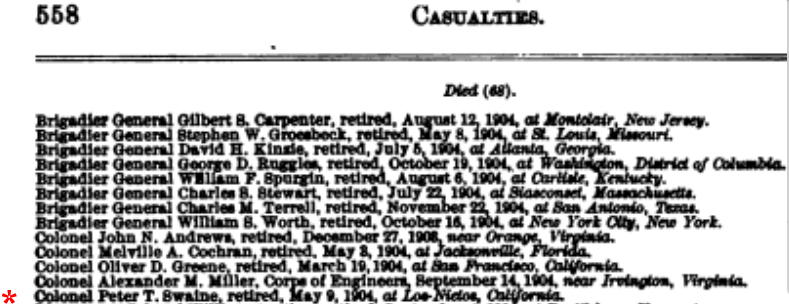
Birth: Jan. 21, 1831
New York
New York County (Manhattan)
New York, USA
Burial:
Angelus Rosedale Cemetery
Los Angeles
Los Angeles County
California, USA
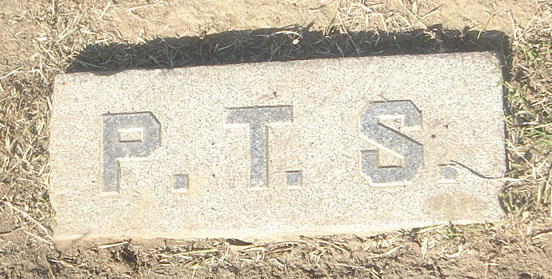
Grave marker for Peter T. Swaine
Photo by TLS from the Find A Grave website
|
Grave monument for Peter T. Swaine Photo by TLS from the Find A Grave website |
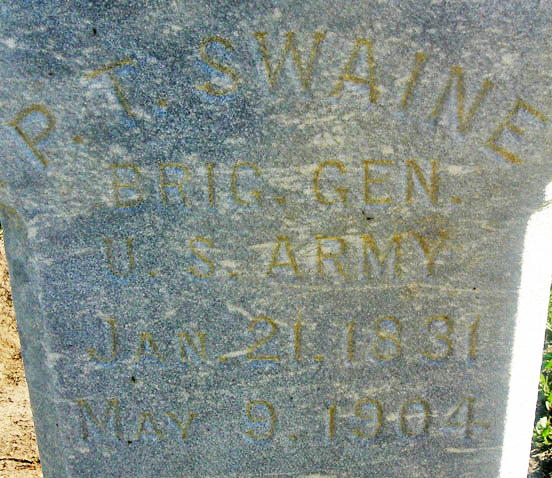
Inscription on the monument for Peter
T. Swaine.
Note that his monument is inscribed as "BRIG. GEN."
(Brigadier General)
Photo by TLS from the Find A Grave website
**********************
William Maclay Swaine
Colonel Peter T. Swaine's son,
William Maclay Swaine graduated from the US Military Academy in
1886,
served on frontier duty under his father's command and saw action
in Cuba with the 22nd Infantry.
He served a total of 13 years with the 22nd Infantry. During that
time, from 1895-1899 he served
alongside David Sheridan Stanley, the son of the 22nd Infantry's
first Commander (after its reconstruction
in 1866) David Sloane Stanley. For the only time in its history,
for those four years, the 22nd Infantry Regiment
had two sons of former 22nd Infantry Regimental Commanders among
its ranks simultaneously.
William Maclay Swaine was born
at Camp Floyd, Utah on May 18, 1860. He was offcially appointed
to the
US Military Academy from the State of New Mexico and entered the
Academy on July 1, 1881. In 1883,
because of deficient grades, he was turned back to repeat his
second year. He graduated 51 out of a class of 70
on July 1, 1886. His best subjects were Drawing and Tactics and
his worst subjects were History and Chemistry.
He was a Lieutenant in the Battalion Organization of the Corps of
Cadets. He was a member of the same graduating
class as John J. Pershing.
Upon graduation Swaine was
commissioned a 2nd Lieutenant in the 22nd Infantry and was
assigned to Company C.
He served on frontier duty with the 22nd Infantry at Fort Lyon,
Colorado from September 21, 1886 to June 1, 1888.
He went with the Regiment to Fort Keogh, Montana where he was
stationed until September 1891.
In September 1891, Swaine became
a student at the U.S. Infantry and Cavalry School at Fort
Leavenworth, Kansas.
While at the school he was promoted to 1st Lieutenant of the 3rd
Infantry on November 29, 1892. On December 27,
1892 he was transferred back to the 22nd Infantry, assigned to
Company K. In June 1893 he graduated from the
Infantry and Cavalry School. He rejoined the Regiment at Fort
Keogh and was assigned to Company F.
He was detailed to the Chicago
World's Fair as part of the military contingent from June to
November of 1893.
He then rejoined Company F 22nd Infantry at the Lame Deer Agency
in Montana where he served until March of 1894.
In June of 1896 he went with the Regiment to Fort Crook, Nebraska
where he served until April 18, 1898. He then went
with the Regiment to Mobile, Tampa and landed in Cuba where he
was engaged in the battles of El Caney and Santiago.
Swaine returned to the United
States on September 1, 1898 and became the Mustering Officer for
the
State of Nebraska on September 3, 1898. On March 2, 1899 he was
promoted to Captain of the 22nd Infantry.
His detail as Mustering Officer ended in May of 1899 and he was
transferred to the 1st Infantry on May 5, 1899.
He returned to Cuba with the 1st
Infantry and served at Pinar del Rio on occupation duty from May
1899
to July 1900. He went with the Regiment to the Philippine Islands
where he served from August 1900 to
August 1902. He was on leave in the United States from August to
December of 1902. He returned to the
Philippines where he served from December 1902 to April 1903.
In May of 1903 Swaine took duty
station at Fort Wayne, Michigan. He commanded the post at Fort
Wayne
from May to December of 1905. He returned with the 1st Infantry
to the Philippine Islands where he served
from February 1906 to June 1908.
William retired as a Major from
service related disabilities on March 23, 1909 and died seven
months later
on October 24, 1909.
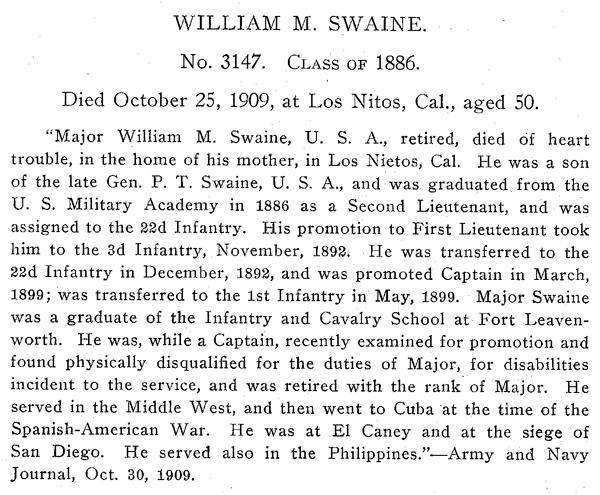
Eulogy for William Maclay Swaine
From the Forty-First Annual
Reunion of the Association of Graduates of the United States
Military Academy
at West Point, New York, June 14, 1910 Seeman &Peters,
Printers & Binders, Saginaw, Michigan
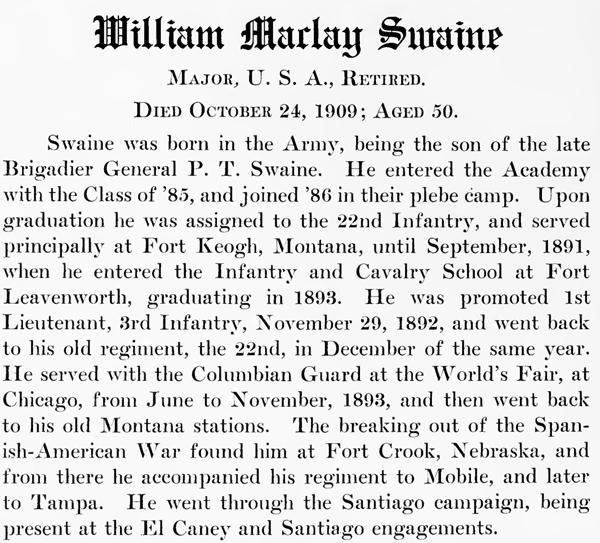
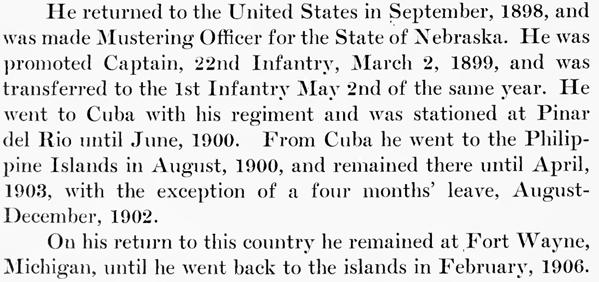
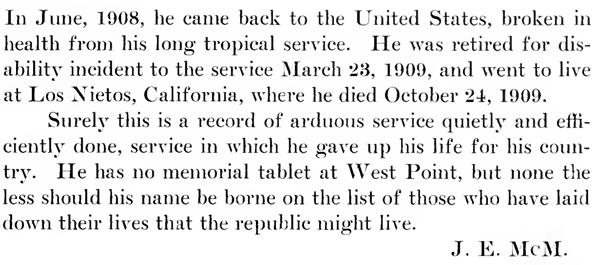
Eulogy for William Maclay Swaine
From: 1886-1911 In
Commemoration of the 25th Anniversary of Graduation
of the Class of '86, U.S.M.A. , West Point, June 1911
William Maclay Swaine was a member of the Military Order of the Carabao.
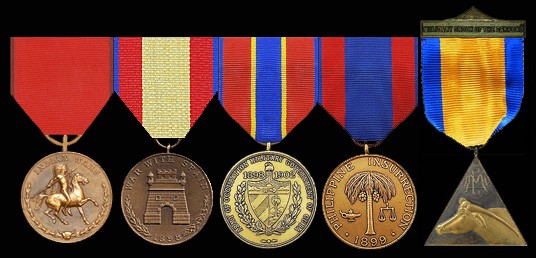
William Maclay Swaine's decorations
Burial:
Angelus Rosedale Cemetery
Los Angeles
Los Angeles County
California, USA
Plot: Section I
|
Grave monument for Photo by TLS from |
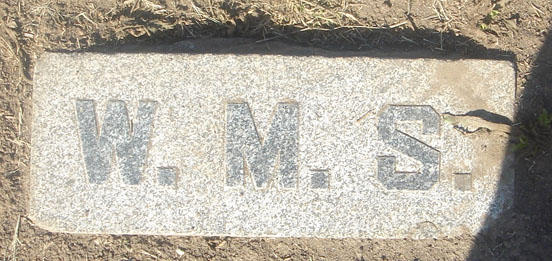
Grave marker for William Maclay Swaine
Photo by TLS from the Find A Grave website
**********************
Top photo of Colonel Peter T. Swaine, taken
while he was Commanding Officer 22nd Infantry,
from Companions of the Military Order of the Loyal Legion of
the United States,
published by L.R. Hamersly Co., New York 1901
That Body of Brave Men: The U.S. Regular Infantry and the
Civil War in the West
Author Mark Wells Johnson
Edition illustrated
Publisher Da Capo Press, 2003
ISBN 0306812460, 9780306812460
Johnson follows the fortunes of the Regular Army regiments in the Western Theatre, specifically the 15th, 16th, 18th and 19th US, who spent much of the later war as the "Regular Brigade" of the Army of the Cumberland. The Regulars provided perhaps 3% of the total Union Army field strength, a majority of which was concentrated in the two brigades of Sykes Regular Division in the Army of the Potomac. The four regiments that served in the West are much less well known, even though their combat record was excellent.
Review by Lawrence P. Duffield
Home | Photos | Battles & History | Current |
Rosters & Reports | Medal of Honor | Killed
in Action |
Personnel Locator | Commanders | Station
List | Campaigns |
Honors | Insignia & Memorabilia | 4-42
Artillery | Taps |
What's New | Editorial | Links |